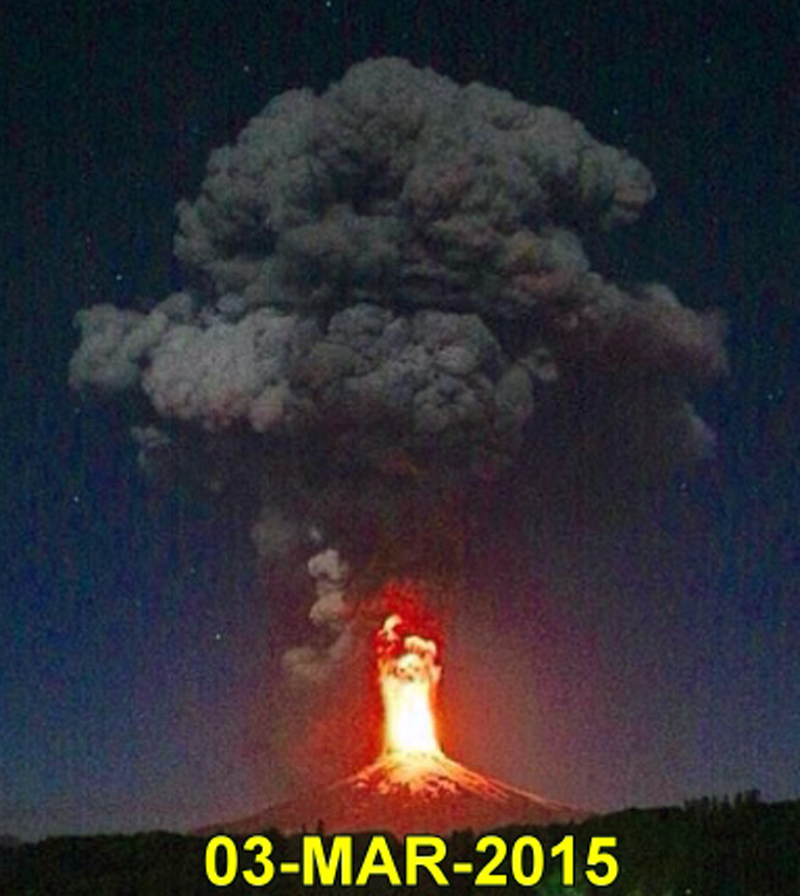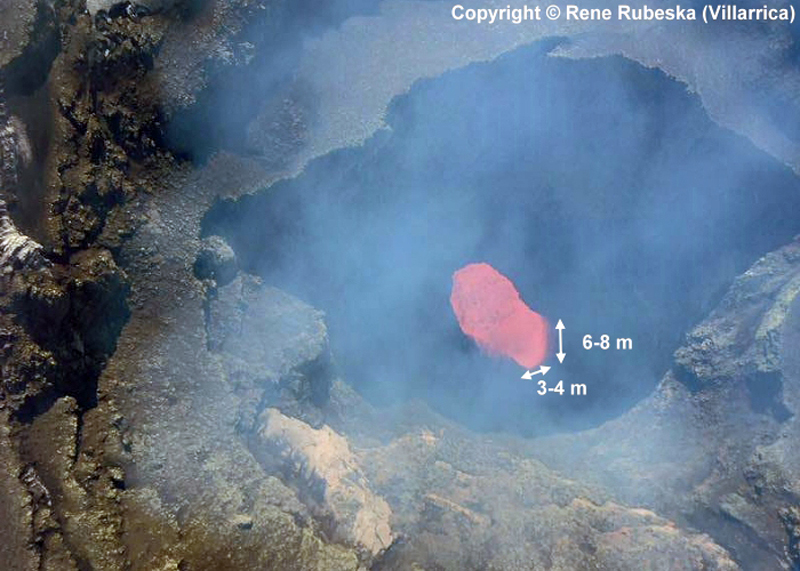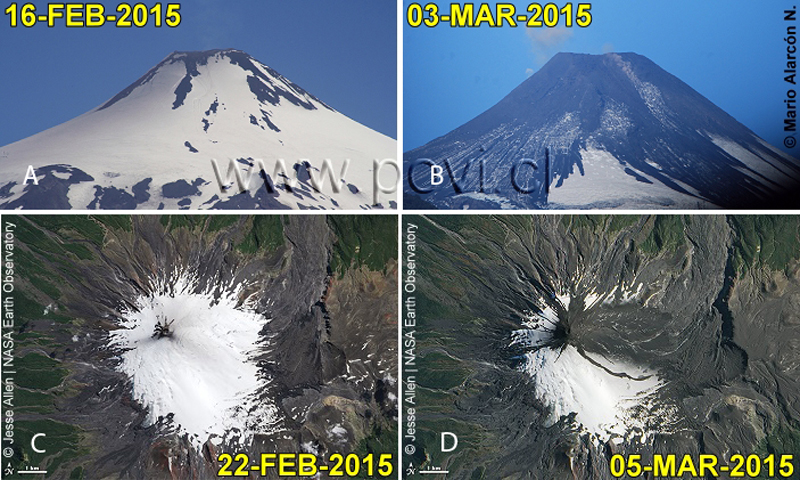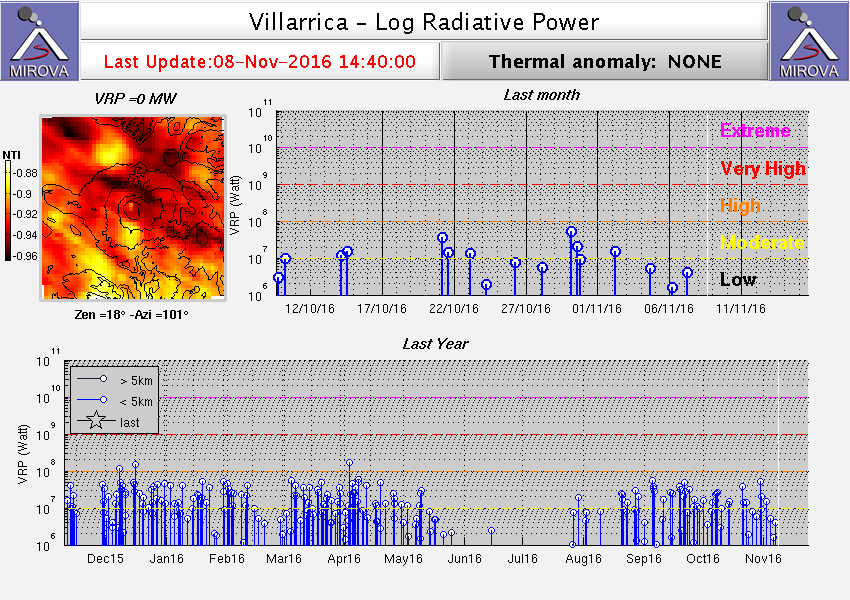Report on Villarrica (Chile) — November 2016
Bulletin of the Global Volcanism Network, vol. 41, no. 11 (November 2016)
Managing Editor: Edward Venzke.
Edited by A. Elizabeth Crafford.
Villarrica (Chile) Lava lake reappears in February 2015 and is ongoing; large ash explosion on 3 March 2015
Please cite this report as:
Global Volcanism Program, 2016. Report on Villarrica (Chile) (Crafford, A.E., and Venzke, E., eds.). Bulletin of the Global Volcanism Network, 41:11. Smithsonian Institution. https://doi.org/10.5479/si.GVP.BGVN201611-357120
Villarrica
Chile
39.42°S, 71.93°W; summit elev. 2847 m
All times are local (unless otherwise noted)
Villarrica is a stratovolcano located 675 km S of Santiago, Chile. Historical eruptions, documented since 1558, have consisted largely of mild-to-moderate explosive activity with occasional lava effusion. An intermittently visible lava lake with Strombolian activity was responsible for persistent MODIS thermal anomalies between November 2009 and April 2012. Very little additional activity was observed until December 2014, when renewed activity was reported by the Southern Andes Volcano Observatory, (Observatorio Volcanológico de Los Andes del Sur, OVDAS) part of Chile's National Service of Geology and Mining (Servicio Nacional de Geología y Minería, SERNAGEOMIN), and Projecto Observación Villarrica Internet (POVI), a privately funded research group that studies Villarrica.
Increased fumarolic and thermal activity was first observed in early December 2014 followed by Strombolian activity and ash emissions during 4-6 February 2015. A large explosion with an ash plume to 9 km altitude took place on 3 March 2015, and continued moderate explosive and Strombolian activity occurred a number of times during March. Explosive activity with ash plumes and lava spattering continued at decreasing levels throughout 2015; in 2016, minor ash emissions were only reported in September. Intermittent Strombolian activity at the lava lake occurred throughout 2015 and 2016 and was recorded as significant thermal anomalies through October 2016.
Activity during 2014. OVDAS reported that seismic activity in 2014 started the year very low with 604 total events in January. Steam plumes remained below 500 m above the summit throughout the year except for one report of heights to 800 m in February. Tremor displacements in 2014 remained in the range of 0.4 to 1.2 cm2 at frequencies of 1.1-1.2 Hz and amplitudes of 0.6-0.7 μm/s, all within background levels. Sulfur dioxide emission values ranged between 180 and 566 metric tons per day (t/d) as monthly averages, with maximum values not over 1,600 t/d throughout the year. The number of seismic events increased from 1,160 in April to 3,269 in May 2014, and took a larger jump between June and July from 4,268 to 11,031. The number of monthly seismic events remained in the 10,000-12,000 range through 2014, while the other parameters measured by OVDAS remained stable. There were no reported ash emissions.
As a privately funded research group, POVI documents activity at the volcano with webcams, photographs, and frequent summit ascents. They first observed increased sulfurous fumarolic activity on 25 November 2014. They also reported on NASA ASTER IR observations of a progressive increase in spectral brightness in satellite data on 10 and 26 November and 3 December. POVI observed the presence of particulate matter suspended over Villarrica on 9 December, and a light dusting of material within 1,000 m of the summit the following day. Increased acoustic activity of loud explosions of gases inside the 40-m-wide volcanic vent at the summit crater were reported during 10-12 December.
OVDAS reported on 18 December 2014 that the seismic energy had abruptly declined on 9 December. A flyover by the Oficina Nacional de Emergencia - Ministerio del Interior (ONEMI), the National Emergency Office of the Ministry of Interior and Public Safety, on 17 December was not able to observe the bottom of the crater due to weather conditions. In January 2015 seismic activity returned to previous levels and other measurements remained at background levels.
Activity during 2015. On 4 and 5 February 2015 POVI observed the first Strombolian eruptions inside of the summit crater vent since April 2012, and constant strong degassing occurring in 10 minute pulses. On 6 February they captured nighttime images of incandescent explosions rising to 65 m above the crater edge. Spatter fragments up to 40 cm were scattered around the summit. POVI also recorded two ash explosions on 6 February, and photographed 5 m diameter incandescent blocks on 7 February in the air 45 m above the crater.
A gradual increase in the amplitude of the seismic tremor signal was reported by OVDAS beginning on 6 February. The seismic signal rose from DR (Reduced Displacement) values of 4.0 cm2 to 24 cm2, and amplitudes increased to 18.5 μm/s, considered moderate to high for Villarrica and significantly above its background values of 2 cm2 and 1 μm/s. The location of the tremor signal was also shallower than it had been previously.
During the night of 9-10 February, POVI observed about 24 Strombolian explosions that rose above the crater rim and sent large blocks several meters down the NW flank. MODVOLC thermal anomalies pixels first reappeared on 14 February 2015. Between 14 and 16 February two active lava lakes were observed by POVI within the summit crater in nighttime imagery and during a flyover. OVDAS reported up to five explosions per minute at the summit crater on 16 February and continued nighttime incandescence since 6 February accompanied by intermittent ash emissions. Ejecta on 16 February was observed up to 1 km away on the S flank. Temperatures close to 800°C were measured that day near the lava lake surface on a flyover supported by ONEMI; tephra was observed around the crater rim and a thin layer of ash was distributed on the flanks. This caused SERNAGEOMIN to raise the alert level from Green to Yellow (1 to 2) on a 4-level scale.
A further increase in seismic energy release was reported by OVDAS on 28 February 2015 with DR values increased to 35 cm2, along with observations of nighttime incandescence and Strombolian explosions ejecting tephra up to 1 km from the crater. Two days later SERNAGEOMIN raised the alert level to Orange (3 of 4) based on increased DR values close to 80 cm2 and seismic amplitudes of 40 μm/s, as well as increased Strombolian activity and bombs ejected to 500-600 m from the crater.
An explosion early in the morning of 3 March 2015 with a 3-km-high ash plume, DR values near 400 cm2, and seismic amplitudes of 1,400 μm/s prompted SERNAGEOMIN to raise the alert level to Red (4 of 4) that morning. They reported observations from cameras around the volcano of a 1.5-km-tall lava fountain (figure 30). The Buenos Aires VAAC (Volcanic Ash Advisory Center) reported a plume to 9.1 km altitude drifting ESE later in the day. Significant ashfall was also visible around the flanks shortly after the explosion (figure 31).
 |
Figure 30. Explosive eruption at Villarrica on 3 March 2015, photographed from the city of Villarrica, 30 km NW of the volcano. The lava fountain was reported as 1.5 km tall. Courtesy of POVI. |
The alert level was lowered back to Orange (3 of 4) on 6 March 2015 as activity decreased. During a flyover on 9 March, OVDAS scientists observed that the vent inside the crater was partially obstructed with debris, and fumarolic activity was weak. Minor debris avalanches had significantly decreased and the alert level was lowered to Yellow (2 of 4) on 10 March. A minor ash emission, under 100 m above the crater, occurred on 15 March. Two weak Strombolian explosions to 150 m above the crater were reported by OVDAS on 17 March. During 17-18 March, continued explosions with volcanic bombs, incandescence, and fine ash caused SERNAGEOMIN to raise the alert level back to Orange. POVI observed ash drifting E less than 70 m above the crater during this time.
The Buenos Aires VAAC reported water vapor and light ash emissions to 3 km beginning 22 March, drifting 45 km SE and continuing intermittently through 25 March. OVDAS reported sporadic incandescence throughout this time and intermittent ash plumes generally 100-500 m above the crater. POVI had also noted pulsating emissions of fine ash during 18-25 March. A significant increase in activity on 25 March led to a 700-m-high plume with high ash content, and visible incandescence. A flyover by OVDAS/ONEMI that day confirmed the presence of the lava lake near the surface again with temperatures around 1,000°C. The Buenos Aires VAAC reported a 5.5-km-high ash plume on 27 March extending 55 km NE. Plume heights exceeded 800 m on 28 March, with ejecta from the lava lake landing around the summit and upper flanks, and night incandescence. Strombolian explosions were observed for most of the night on 30 March. The highest explosion of spatter reached 300 m above the crater, and material fell 500 m away onto the flanks. That same day the Buenos Aires VAAC reported continuous ash emissions with a plume to 3.7 km drifting NE. On 31 March they reported irregular intermittent water vapor with small puffs of ash that were observed on the OVDAS web camera.
Strombolian activity fluctuated during April 2015. Pulsating emissions of water vapor were common. OVDAS reported ash plumes to 700 m above the summit crater on 4-5 and 20-21 April but otherwise periodic ash plumes were below 500 m. Buenos Aires VAAC reported the 5 April ash plume rising to 3.7 km altitude and drifting 16 km SSE. Ejecta occasionally reached 200 m from the crater. Nighttime incandescence from the crater was usually observed during clear weather, and seismicity generally decreased during the month. The lava lake and the formation of an incipient pyroclastic cone inside the inner crater were observed in an OVDAS/ONEMI flyover on 9 April; on a 21 April flight moderate Strombolian activity was viewed restricted to the interior of the crater.
During May 2015, OVDAS reported small Strombolian explosions from the lava lake, diffuse gas emissions with occasional ash, nighttime crater incandescence, and decreasing seismicity. Activity continued to gradually decline, and on 8 June the Alert Level was lowered to Yellow.
Sporadic incandescence was still observed during clear weather between June and September 2015, with plume heights below 450 m except for occasional plumes to 700 m above the summit crater. Two ash emissions were recorded on the OVDAS cameras on 18 and 21 September to heights less than 400 m. Plume heights in October were near 700 m, and another small ash emission was recorded on 31 October along with incandescence on clear nights. A group of OVDAS scientists conducted a field visit on 27 October and observed 11 new small fumaroles on the inner wall of the crater, and steep walls of pyroclastic material generated in the explosions from earlier in the year. They observed the lava lake in an overflight on 29 October and the temperature of the lake was measured at 850°C (figure 32). During the second week of November weak explosions were heard and pyroclastic material was observed above the crater rim; plume heights were close to 400 m, but rose to 700 m in December. A particulate emission that rose to 200 m above the crater occurred on 15 December. SERNAGEOMIN lowered the alert level to Green on 31 December 2015.
 |
Figure 32. Lava lake at Villarrica on 31 October 2015. Oblique aerial image shows the crater, about 80 m deep, and dimensions of the lava lake. Image copyright by René Rubeska. Courtesy of POVI. |
Although ash emissions and Strombolian activity were intermittent and generally decreasing after June 2015, strong thermal anomalies seen in MODVOLC data continued throughout the year. February, March, July, August, October, and November each had between 5 and 10 days with thermal anomalies while April, May, June, September, and December all had between 10 and 15 days with MODVOLC alert pixels, indicating continued activity at the lava lake.
Activity during 2016. Water vapor plumes rose to 600 m above the crater in January and February 2016, along with slightly increased SO2 emissions and night incandescence. Small ash emissions on 6 and 29 February and the formation of a small pyroclastic cone inside the crater were observed by visiting scientists from the University of Cambridge. One VT (volcano-tectonic) earthquake of M 3.7, larger than normal, was reported by OVDAS on 26 March; it was located 4.7 km ESE of the crater at a depth of 4.2 km. This was followed by a spike in the number of VT events the following day. The amplitude and frequency values associated with seismic tremors remained within normal levels until a sudden but brief increase on 3 April that was associated with explosions and minor Strombolian activity at the lava lake within the crater. This activity resulted in SERNAGEOMIN raising the alert level to Yellow. The frequency of clusters of VT seismic events increased during the second week in April; most were located in a NW-SE trending belt about 10 km long near the crater vent. Water vapor plumes continued rising to around 600-700 m above the crater during April and May with no significant changes in incandescence. OVDAS reported small emissions of particulate material around the crater in April and on 4 May. The alert level was lowered back to Green on 16 May.
From May through July 2016, only water vapor plumes between 300 and 700 m above the summit were reported by OVDAS. August was quieter still with plumes rising to only 150 m. Seismicity increased slightly in September, plumes rose to 600 m, and on four days (5, 10, 19, 24) small emissions of ash were observed. Water vapor plumes remained below 700 m in October, 2016.
While significant explosive activity did not occur during the year through October 2016, the lava lake remained visible and active, causing thermal anomalies recorded by MODIS and measured by both the MODVOLC and MIROVA systems. MODVOLC recorded thermal anomalies between 5 and 10 times each month from January through April, between 1 and 4 times in May, July, and August, and again between 5 and 10 times in September and October. This variation is also reflected in the MIROVA Log Radiation Power graph for 2016 (figure 33).
Geological Summary. The glacier-covered Villarrica stratovolcano, in the northern Lakes District of central Chile, is ~15 km south of the city of Pucon. A 2-km-wide caldera that formed about 3,500 years ago is located at the base of the presently active, dominantly basaltic to basaltic-andesite cone at the NW margin of a 6-km-wide Pleistocene caldera. More than 30 scoria cones and fissure vents are present on the flanks. Plinian eruptions and pyroclastic flows that have extended up to 20 km from the volcano were produced during the Holocene. Lava flows up to 18 km long have issued from summit and flank vents. Eruptions documented since 1558 CE have consisted largely of mild-to-moderate explosive activity with occasional lava effusion. Glaciers cover 40 km2 of the volcano, and lahars have damaged towns on its flanks.
Information Contacts: Servicio Nacional de Geología y Minería, (SERNAGEOMIN), Observatorio Volcanológico de Los Andes del Sur (OVDAS), Avda Sta María No. 0104, Santiago, Chile (URL: http://www.sernageomin.cl/); Proyecto Observación Villarrica Internet (POVI) (URL: http://www.povi.cl/); Hawai'i Institute of Geophysics and Planetology (HIGP), MODVOLC Thermal Alerts System, School of Ocean and Earth Science and Technology (SOEST), Univ. of Hawai'i, 2525 Correa Road, Honolulu, HI 96822, USA (URL: http://modis.higp.hawaii.edu/, http://modis.higp.hawaii.edu/cgi-bin/modisnew.cgi); Oficina Nacional de Emergencia - Ministerio del Interior (ONEMI), Beaucheff 1637/1671, Santiago, Chile (URL: http://www.onemi.cl/); Buenos Aires Volcanic Ash Advisory Center (VAAC), Servicio Meteorológico Nacional-Fuerza Aérea Argentina, 25 de mayo 658, Buenos Aires, Argentina (URL: http://www.smn.gov.ar/vaac/buenosaires/inicio.php?lang=es); NASA Earth Observatory, EOS Project Science Office, NASA Goddard Space Flight Center, Goddard, Maryland, USA (URL: http://earthobservatory.nasa.gov/); MIROVA (Middle InfraRed Observation of Volcanic Activity), a collaborative project between the Universities of Turin and Florence (Italy) supported by the Centre for Volcanic Risk of the Italian Civil Protection Department (URL: http://www.mirovaweb.it/).



